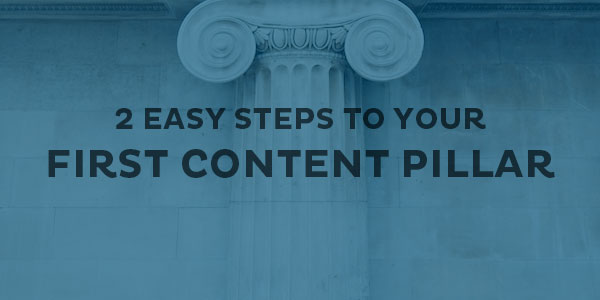The content pillar approach is one of the most efficient—and effective—ways to get your integrated content operation functioning.
Content pillars drive as many as 4x the leads and 3x the closed deals as compared to other marketing campaigns. But how do you get started? It’s not as hard as it seems.
Wait, What’s a Content Pillar?
A “content pillar” is a substantive piece of content on a specific topic or theme which can be broken into many derivative assets. These smaller pieces then drive traffic back to the main asset, which people download in exchange for their contact information.
“Pillar content is central to this new strategy. It is typically comprised of a single page — such as a website or landing page — that offers a comprehensive view of the topic.” Jeffrey Vocell, Hubspot
When done well, it’s a win-win for businesses and buyers: The business generates leads, and the buyer gets valuable and useful information.
When creating a content pillar, the goal is to create a high quality, buyer-centric asset which can be broken down and shared across channels. Because the derivative materials come from the same foundation, it’s easy to retain a cohesive voice across the individual content assets and their channels.
“The content pillar approach centers around a consistent messaging strategy.” Todd Cameron, Strategy Director
It may seem like a lot of work to create a content pillar—and it is. But don’t start from scratch for your first pillar campaign.
Instead, pull from what you already have.
How to Repurpose Current Content and Resources
Use content you’ve already created to get the wheels turning on your content operation. To see how the content pillar approach works, Todd Cameron, Strategy Director at Kapost, recommends reviewing a prior campaign to help you think through the strategy.
“Look at a product release from the previous year. Review all the work you did for that campaign. Look at the blog, or any coverage you got. Collect it all, create a map of that campaign. Then, look at how it could have been created more efficiently from a cross-functional way.”
Chances are, you could have easily repurposed much of the content created around that campaign across channels and networks, instead of relying on each siloed marketing group to create original, and ultimately disjointed, content for their channels.
Here are two ways to get a jump on the content pillar approach.
1. Start with Current Content, Such as Webinars and Case Studies
Case studies or webinars are a good place to start building a content pillar. This is because webinars and case studies often house a vault of information. Think through why your buyers would be interested in this content, and which challenges and needs it addresses.
“A pillar piece will typically map to a larger marketing theme,” Cameron says. “Many companies think about it from a product release perspective. But you need to back up and ask, ‘Why did we create this?’”
Understand and define the personas you’re trying to engage with this asset, and use your persona research to strategize where and how you can reach them on different channels and stages of their buying cycle.
2. Think Small, Short, and Shareable
By starting with a larger asset (like a case study or webinar), you can get creative with how you use it to inform smaller, snackable content. Write down interesting quotes. Pull aside statistics or data. Think about ways themes or topics can be presented visually.
Deliver this content across distribution channels and marketing groups, minimizing extra work and establishing an integrated marketing approach.
“No buyer reads everything…repurpose exactly what you write in the blog for a tweet.” Todd Cameron, Strategy Director
This is the beauty of a content pillar.
To truly test whether or not you’ve maintained a cohesive brand voice, “read all these materials from a buyer’s perspective. If you read these different pieces across channels—social, blog, website, videos, emails—do they make sense? Is the messaging consistent?” Todd says.
No need to start from scratch. Get going quickly by building out a content pillar with your best assets. These quick wins will make all the difference when getting your team and organization on board, and will likely drive boosted lead generation. With this approach, you’ll be able to scale a content-focused, buyer-centric operation in weeks instead of months.


